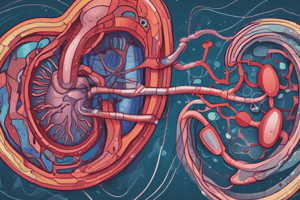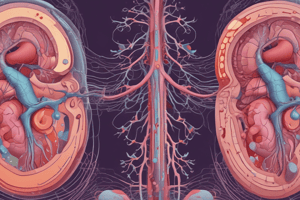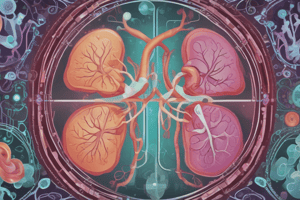Podcast
Questions and Answers
What are the 3 phases of Acute Kidney Injury?
What are the 3 phases of Acute Kidney Injury?
- Pre-renal, Intra-renal, Post-renal (correct)
- Acute, Subacute, Chronic
- Phase 1, Phase 2, Phase 3
- Primary, Secondary, Tertiary
Which of the following is NOT a common clinical manifestation of expected clinical manifestations in someone with AKI?
Which of the following is NOT a common clinical manifestation of expected clinical manifestations in someone with AKI?
- Oliguria
- Increased Creatinine and BUN
- Urine Concentrate
- Hypotension (correct)
What are possible complications of fluid volume overload in someone with AKI?
What are possible complications of fluid volume overload in someone with AKI?
- Anasarca
- Hyperkalemia
- LOC changes
- All of the above (correct)
- None of the above
What is the priority nursing action when treating a patient with AKI?
What is the priority nursing action when treating a patient with AKI?
Maintaining a Mean Arterial Pressure (MAP) above 65 mmHg is crucial for AKI treatment.
Maintaining a Mean Arterial Pressure (MAP) above 65 mmHg is crucial for AKI treatment.
What is the purpose of a fluid challenge in AKI?
What is the purpose of a fluid challenge in AKI?
Which laboratory results are typically elevated in patients with AKI?
Which laboratory results are typically elevated in patients with AKI?
What image would you use to rule out obstruction in someone with AKI?
What image would you use to rule out obstruction in someone with AKI?
What might you order if you wanted to visualize the structures of the abdomen and pelvis in a patient with AKI?
What might you order if you wanted to visualize the structures of the abdomen and pelvis in a patient with AKI?
What is the name of the procedure used to identify if there is a kidney stone or obstruction in someone with AKI?
What is the name of the procedure used to identify if there is a kidney stone or obstruction in someone with AKI?
What is the name of the diagnosis that characterizes a patient with irreversibly damaged kidneys?
What is the name of the diagnosis that characterizes a patient with irreversibly damaged kidneys?
What are some common expected metabolic changes associated with ESRD?
What are some common expected metabolic changes associated with ESRD?
Flashcards
What is Acute Kidney Injury (AKI)?
What is Acute Kidney Injury (AKI)?
A sudden decrease in kidney function that occurs over hours or days. Can be caused by problems before, inside, or after the kidneys.
What are the causes of prerenal AKI?
What are the causes of prerenal AKI?
Reduced blood volume, low blood pressure, blockage in renal arteries or veins.
What are the causes of intrarenal AKI?
What are the causes of intrarenal AKI?
Conditions affecting the kidneys themselves: glomerulonephritis, NSAID use, contrast dye exposure.
What are the causes of postrenal AKI?
What are the causes of postrenal AKI?
Signup and view all the flashcards
What are the clinical manifestations of AKI?
What are the clinical manifestations of AKI?
Signup and view all the flashcards
What are some complications of AKI?
What are some complications of AKI?
Signup and view all the flashcards
What are the priority nursing actions related to AKI?
What are the priority nursing actions related to AKI?
Signup and view all the flashcards
What interventions can be used to manage AKI?
What interventions can be used to manage AKI?
Signup and view all the flashcards
What is Chronic Kidney Disease (CKD)?
What is Chronic Kidney Disease (CKD)?
Signup and view all the flashcards
What is End-Stage Renal Disease (ESRD)?
What is End-Stage Renal Disease (ESRD)?
Signup and view all the flashcards
What is uremia?
What is uremia?
Signup and view all the flashcards
What are the metabolic changes in ESRD?
What are the metabolic changes in ESRD?
Signup and view all the flashcards
What is cardiorenal syndrome?
What is cardiorenal syndrome?
Signup and view all the flashcards
What are the hematological complications of ESRD?
What are the hematological complications of ESRD?
Signup and view all the flashcards
What are the gastrointestinal complications of ESRD?
What are the gastrointestinal complications of ESRD?
Signup and view all the flashcards
What are the musculoskeletal complications of ESRD?
What are the musculoskeletal complications of ESRD?
Signup and view all the flashcards
What are the priority nursing interventions for ESRD?
What are the priority nursing interventions for ESRD?
Signup and view all the flashcards
What dietary teaching is important for patients with ESRD?
What dietary teaching is important for patients with ESRD?
Signup and view all the flashcards
What is hemodialysis?
What is hemodialysis?
Signup and view all the flashcards
What are the nursing considerations during hemodialysis?
What are the nursing considerations during hemodialysis?
Signup and view all the flashcards
What is an arteriovenous (AV) fistula?
What is an arteriovenous (AV) fistula?
Signup and view all the flashcards
What are the nursing considerations for AV fistulas?
What are the nursing considerations for AV fistulas?
Signup and view all the flashcards
What is peritoneal dialysis?
What is peritoneal dialysis?
Signup and view all the flashcards
What are the nursing considerations for peritoneal dialysis?
What are the nursing considerations for peritoneal dialysis?
Signup and view all the flashcards
What is acute pancreatitis?
What is acute pancreatitis?
Signup and view all the flashcards
What are the diagnostics for acute pancreatitis?
What are the diagnostics for acute pancreatitis?
Signup and view all the flashcards
What are the priority nursing interventions for acute pancreatitis?
What are the priority nursing interventions for acute pancreatitis?
Signup and view all the flashcards
What is chronic pancreatitis?
What is chronic pancreatitis?
Signup and view all the flashcards
What are the nursing interventions for chronic pancreatitis?
What are the nursing interventions for chronic pancreatitis?
Signup and view all the flashcards
What is cirrhosis?
What is cirrhosis?
Signup and view all the flashcards
What are the clinical manifestations of cirrhosis?
What are the clinical manifestations of cirrhosis?
Signup and view all the flashcards
What are the nursing interventions for cirrhosis?
What are the nursing interventions for cirrhosis?
Signup and view all the flashcards
Study Notes
Renal Study Guide Exam 1
- Acute Kidney Injury (AKI):
- Caused by nephrotoxic drugs, occurring in hours or days.
- Three phases: prerenal, intrarenal, and postrenal.
- Prerenal: Caused by decreased blood volume/pressure (e.g., heart failure, renal artery stenosis).
- Intrarenal: Problems inside the kidney (e.g., glomerulonephritis, lupus nephritis, NSAIDs, contrast dyes).
- Postrenal: Obstructions after the kidney (e.g., kidney stones, BPH).
Expected Clinical Manifestations
- Oliguria: Urine output less than 0.5 mL/kg/hr.
- Increased creatinine and BUN: Elevated levels indicate kidney dysfunction.
- Fluid volume overload: Anasarca (generalized edema).
- Other complications: Seizures, asterixis (hand tremor), hyperkalemia, metabolic acidosis, bounding pulse, JVD, tachycardia, and changes in lung sounds.
Nursing Actions
- Priority: Prevent AKI
- Recognition: Identify early signs.
- Fluid status: Assess daily hydration and weight.
- Urine characteristics: Monitor for color, concentration, and other characteristics.
Risk Factors
- Nephrotoxic agents.
- Contrast media.
- Advanced age.
Interventions
- Maintain mean arterial pressure (MAP) >65 mm Hg.
- Diuretics therapy
- Fluid challenge
- Hemodynamic monitoring
- Nutrition (Protein, sodium, potassium restrictions)
Specific Labs and Diagnostics
- Arterial blood gases (ABGs)
- Ultrasound of kidneys
- CT of abdomen/pelvis
- KUB
- Cystoscopy
- Kidney biopsy
Chronic Kidney Disease (ESRD)
- Progressive and irreversible kidney dysfunction.
- End-stage occurs when kidney function cannot sustain life.
- Expected lab values: Increased BUN, creatinine (Uremia), metallic taste, anorexia, N/V, muscle cramps, pruritus, edema, dyspnea, paresthesia.
Complications of AKI and ESRD
- Various complications can arise including but not limited to cardiovascular issues, fluid imbalances and electrolyte abnormalities, neurological complications.
Complications of Hemodialysis
- Complications include hypotension, headache, nausea, dizziness, muscle cramps, disequilibrium syndrome, restless, headache.
- Nursing care of AV fistula/graft; aseptic technique, BP monitoring, no sticks, evaluate for infections and swelling, and monitor distal pulses.
- Concerns: PVCs occurrence (Hyperkalemia)
Peritoneal Dialysis
- Repeated cycles of fluid instillation into the peritoneal cavity.
- Complications: Peritonitis, exit-site/tunnel infections, pain, bleeding at site, poor flow, dialysate leakage, bowel perforation.
Acute Pancreatitis
- Intense, continuous pain, frequently in the upper abdomen.
- Associated with symptoms of nausea and vomiting.
- Can present with complications such as cardio-renal syndrome, shock, pneumonia, pleural effusions, and atelectasis, and neurological complications such as ataxia, peripheral neuropathy, tremors, seizures and coma.
Cardiovascular Study Guide
- Causes of Angina (Chest Pain): Ischemic heart disease.
- Stable angina: Occurs with exertion and is relieved by rest or nitroglycerin.
- Unstable angina: Chest pain or discomfort not relieved by rest or nitroglycerin.
- Diagnoses: EKG, stress test, CT/MRI, echocardiogram, coronary angiography, cardiac catheterization, chest x-ray.
- Medications: Nitroglycerin, hypertensives, beta-blockers, calcium channel blockers, statins, anticoagulants.
Myocardial Infarction (MI)
- Presentation: Severe chest pain lasting longer than 30 minutes, not relieved by nitroglycerin. Shortness of breath, nausea, vomiting (N/V), diaphoresis.
- Diagnostics: EKG, cardiac enzymes (Troponin).
Cardiovascular Complications (e.g., heart failure, cardiac tamponade)
- Heart failure: Left-sided=pulmonary congestion, right-sided=systemic congestion.
- Cardiac tamponade: Compression of the heart due to the accumulation of fluid in the pericardial sac.
Endocarditis
- Infection of the inner lining of the heart.
- Treatments with antibiotics (Antimicrobials, IV).
- Monitoring: education on good oral hygiene
- Ongoing monitoring and reporting of recurring symptoms.
Dilated Cardiomyopathy
- Cardiomyopathy characterized by the enlargement of the heart muscle.
- Interventions to lower blood pressure, and symptoms management.
Abdominal Aortic Aneurysm (AAA)
- A bulge or weakening in the wall of the aorta.
- Signs and symptoms: Abdominal pain, pulsatile mass, and possible rupture (hypovolemic shock).
- Diagnostics: CT, ultrasound.
- Treatment: Surgery or medical management
Surgical Management of AAA and Aortic Dissection
- Surgical repairs and interventions for AAAs and aortic dissection.
- Risk factors for complications: complications of the procedure, and bleeding.
- Post-operative monitoring and care.
Studying That Suits You
Use AI to generate personalized quizzes and flashcards to suit your learning preferences.




